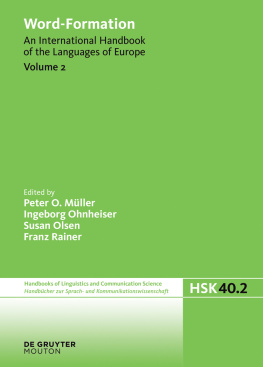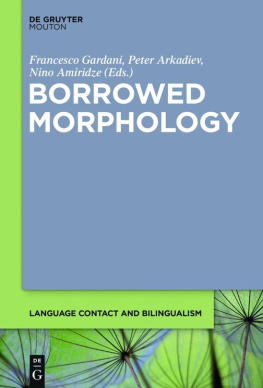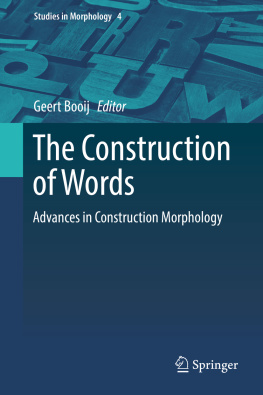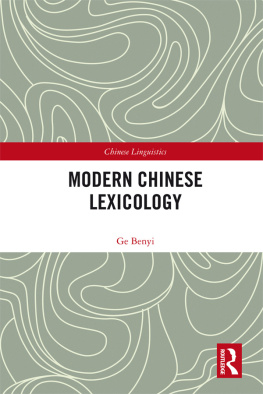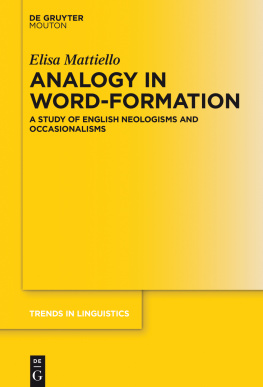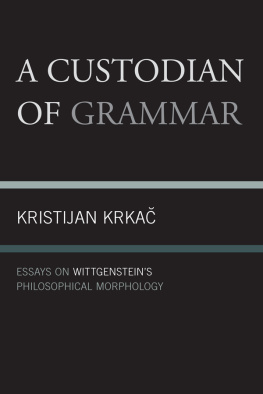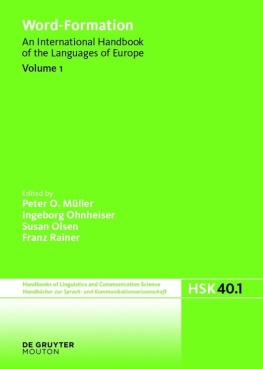Zeki Hamawand - Morphology in English: Word Formation in Cognitive Grammar
Here you can read online Zeki Hamawand - Morphology in English: Word Formation in Cognitive Grammar full text of the book (entire story) in english for free. Download pdf and epub, get meaning, cover and reviews about this ebook. year: 2011, publisher: Continuum, genre: Science. Description of the work, (preface) as well as reviews are available. Best literature library LitArk.com created for fans of good reading and offers a wide selection of genres:
Romance novel
Science fiction
Adventure
Detective
Science
History
Home and family
Prose
Art
Politics
Computer
Non-fiction
Religion
Business
Children
Humor
Choose a favorite category and find really read worthwhile books. Enjoy immersion in the world of imagination, feel the emotions of the characters or learn something new for yourself, make an fascinating discovery.
- Book:Morphology in English: Word Formation in Cognitive Grammar
- Author:
- Publisher:Continuum
- Genre:
- Year:2011
- Rating:5 / 5
- Favourites:Add to favourites
- Your mark:
- 100
- 1
- 2
- 3
- 4
- 5
Morphology in English: Word Formation in Cognitive Grammar: summary, description and annotation
We offer to read an annotation, description, summary or preface (depends on what the author of the book "Morphology in English: Word Formation in Cognitive Grammar" wrote himself). If you haven't found the necessary information about the book — write in the comments, we will try to find it.
Zeki Hamawand: author's other books
Who wrote Morphology in English: Word Formation in Cognitive Grammar? Find out the surname, the name of the author of the book and a list of all author's works by series.
Morphology in English: Word Formation in Cognitive Grammar — read online for free the complete book (whole text) full work
Below is the text of the book, divided by pages. System saving the place of the last page read, allows you to conveniently read the book "Morphology in English: Word Formation in Cognitive Grammar" online for free, without having to search again every time where you left off. Put a bookmark, and you can go to the page where you finished reading at any time.
Font size:
Interval:
Bookmark:

Morphology in English
A companion website to accompany this book is available online at:
http://linguistics.hamawand.continuumbooks.com
Please visit the link and register with us to receive your password and access these downloadable resources.
If you experience any problems accessing the resources, please contact Continuum at:
Also available from Continuum
A Critical Introduction to Syntax, Jim Miller
The Grammar Detective, Gillian Hanson
Syntax in Functional Grammar, G. David Morley
Morphology
in English
Word Formation in
Cognitive Grammar
Zeki Hamawand

To the memory of my parents
Contents
Acknowledgements
Writing a textbook on morphology, particularly within the discipline of Cognitive Linguistics is a daring enterprise. It is fraught with difficulties and rife with pitfalls. In the course of preparing the textbook, a number of people have contributed directly or indirectly to its evolution. First, I owe a special debt of gratitude to Ronald Langacker for checking the linguistic content. His acute observations helped make the argument sound. Second, I record my indebtedness to Struan Robertson for proofreading the manuscript. His pertinent suggestions contributed to textual clarity. Third, I am grateful to Pavel Stekauer for devoting his time to reading an earlier draft of the work, giving perspicacious remarks and invaluable feedback. Fourth, I would like to express my deepest appreciation to Gurdeep Mattu, the Linguistics Editor at Continuum, for his guidance in bringing the project to fruition, and the remaining staff for their diligence in producing and distributing the textbook. Finally, I will be grateful if readers provide suggestions for improving future editions of the textbook. Responsibility for errors is, of course, entirely my own.
Zeki Hamawand
Preface
Morphology in English: Word Formation in Cognitive Grammar is a textbook which provides an in-depth analysis of English morphology. Theoretically, the framework is rooted in Langacker (1987, 1991). Practically, it is based on Hamawand (2007, 2008, 2009). Morphology is a branch of linguistics which studies the form-meaning relationships between the subparts of composite words in the lexicon. It aims to show how the subparts are integrated and how the resulting formations are interpreted. A composite word consists of two or more subparts, one of which imposes its profile on the entire structure. The description of a composite word involves two aspects. One is substance, which consists of two facades: form or the phonological representation, and meaning or the semantic content. The form serves to express meaning. The other is use, the purpose for or way in which a composite word is employed. The use of a composite word is determined by the way the language user construes a situation, which differs relative to the demands of discourse. The substance of a composite word is activated as a response to language use.
The lexicon is a network of morphological units which the language user associates in conformity with cognitive principles. Morphological units display three linguistic characteristics. One characteristic pertains to linguistic multiplicity, whereby a particular morpheme has a series of interrelated senses which gather around a prototype. The senses are organized in terms of distance from the prototype, based on the degree of similarity. Another characteristic revolves around linguistic relationship, whereby different morphemes cluster in domains defined by two types of relation: one is of similarity vis--vis the overall concept of the domain they form; the other is of difference with respect to the specific functions they perform within the domain. A further characteristic relates to linguistic alternation, whereby two, or more, rival morphemes attach to the same root and derive new forms. The resulting forms, namely the alternatives, differ with respect to the construal imposed on them. Each alternative represents a different construal, and thus has a meaning that is uniquely its own.
Goals
To come to grips with morphology, the textbook links theory with practice. It has, therefore, two goals: theoretical and practical. The theoretical goal is to acquaint students with the three theories of word meaning, highlighting its impact on form. In the light of category theory, morphemes are argued to have multiple meanings, which gather around prototypical examples, and so display minimal differences in meaning. By virtue of domain theory, morphemes expressing the same concept are argued to form domains, in which they represent discrete facets, and so have different roles to play in the language. With reference to construal theory, two or more morphemes attached to the same root are argued to be distinguishable in meaning, and so the word pairs they form are distinctive in use. The practical goal is to provide students with a comprehensive description of the two essential areas of vocabulary building: derivation and compounding. It aims to develop their skills in analysing morphological expressions, familiarize them with the mechanisms used in forming composite words, and inform them of the techniques employed to account for their interpretation.
Contents
The textbook starts with a chapter entitled Fundamentals, which serves to introduce the major terms involved in the field of morphology. The rest of the textbook is divided into four parts. Part I sheds light on the theoretical aspect of the discussion. It offers a synthesis of the leading tenets of the cognitive framework. It consists of three chapters. addresses the cognitive operations. Parts IIIV pertain to the practical aspect of the discussion. Part II deals with prefixation. Part III copes with suffixation. Part IV grapples with compounding. Each part includes chapters on categorization, configuration and construal. Each chapter begins with an overview, where the subject matter, the objective and the procedure are stated. The overview aims to help the student to understand the content before delving into explanations. Each chapter is divided into sections. Each section closes with an exercise. The exercises are meant to reinforce the material presented or introduce new material for investigation. There are appendices at the end of the textbook, which are designed to give additional information about other important areas of morphology.
Audiences
To achieve its mission, the textbook uses an approachable style and embellishes the presentation with cursory sketches. It uses actual data, offers numerous examples and gives vivid explanations. As a textbook, it targets two classes of audience. Primarily, it targets undergraduate and graduate students taking degree courses in linguistics. It provides them with a thorough discussion of the pivotal issues involved in the study of linguistic morphology. It informs them more fully about such productive processes in word formation in English as derivation and compounding. Secondarily, it targets students at English departments. It helps them to expand their vocabulary and understand the conditions under which lexical choices are made. As a guidebook, it targets two classes of audience. First, it targets linguists. Of central significance for them are the cognitive tools employed to account for morphological data. Second, it targets scholars from neighbouring disciplines. Of special interest for them is the description of an area in language study from a new perspective.
Font size:
Interval:
Bookmark:
Similar books «Morphology in English: Word Formation in Cognitive Grammar»
Look at similar books to Morphology in English: Word Formation in Cognitive Grammar. We have selected literature similar in name and meaning in the hope of providing readers with more options to find new, interesting, not yet read works.
Discussion, reviews of the book Morphology in English: Word Formation in Cognitive Grammar and just readers' own opinions. Leave your comments, write what you think about the work, its meaning or the main characters. Specify what exactly you liked and what you didn't like, and why you think so.



